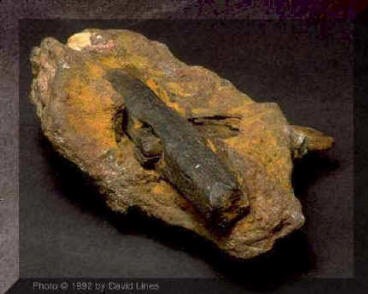 by Sean Pitman
by Sean Pitman
It is most interesting to hear the argument, from judges and scientists, that the concept of “Intelligent Design” is a religious concept that is immune from and outside of the realm of scientific investigation. This is interesting because several mainstream sciences are based on the ability to determine, scientifically, that certain phenomena in nature are true artefacts of deliberate intelligent design.
Of particular interest in this regard are the claims of those who are searching for signs of extra terrestrial intelligence (SETI scientists). How will they know when they’ve found such evidence? Upon what is this search based?
Well, to quote Seth Shostak, a senior astronomer at the SETI Institute:
 Perhaps the extraterrestrials will preface their message with a string of prime numbers, or maybe the first fifty terms of the ever-popular Fibonacci series. Well, there’s no doubt that such tags would convey intelligence.
Perhaps the extraterrestrials will preface their message with a string of prime numbers, or maybe the first fifty terms of the ever-popular Fibonacci series. Well, there’s no doubt that such tags would convey intelligence.
Even though Shostak went on to note that such a signal may be quite difficult to practically impossible to find at great distances, the point remains. Marked internal symmetry or a series of matching irregularities, like a sequence of numbers within a radio signal that match a series of specific prime numbers, the Fibonacci series, or any other simple or even complex mathematical tag, would be very good evidence of artifact when it comes to the medium of radio signals – as well as other materials like granite. And, this is true without any direct knowledge concerning the actual origin of either the radio signals or the granite rocks. In fact, the shape of a granite rock does not need to be “complex” at all before it can be recognized as a “blindingly obvious artefact”. A simple polished cube of granite isn’t very complex, but it is well beyond what can be “naturally” produced and is therefore a clear artefact of intelligent design. The same is true for simple radio signals. They can be very very simple and yet be very clear artefacts of intelligent design – as Shostak explains:
It seems that Nature cannot make a pure-tone radio signal.
So the point is simple and sharp. If we detect a signal from the Stygian depths of space that is the equivalent of a tuning fork’s sinusoidal whistle, then we can feel confident that we have found SETI’s vaunted needle in a haystack: a message from another world…
An endless, sinusoidal signal - a dead simple tone - is not complex; it’s artificial. Such a tone just doesn’t seem to be generated by natural astrophysical processes. In addition, and unlike other radio emissions produced by the cosmos, such a signal is devoid of the appendages and inefficiencies nature always seems to add – for example, DNA’s junk and redundancy.
 So, it seems as though if one can find something that natural mechanisms are not known to produce, and yet are at least approximated by human-level intelligence and design, that such a phenomenon would be considered to be a true artefact of intelligent design – even if found on an alien planet (according to Shostak’s argument).
So, it seems as though if one can find something that natural mechanisms are not known to produce, and yet are at least approximated by human-level intelligence and design, that such a phenomenon would be considered to be a true artefact of intelligent design – even if found on an alien planet (according to Shostak’s argument).
It also seems like Shostak is arguing out of both sides of his mouth. On the one hand he claims that the difference between SETI and the search for intelligent design within living things is that, “the evidence [for ETI] is not predicated on its complexity.” Yet, at the same time, he claims that if a radio signal were to be tagged with some complex mathematical signal, like “the first 50 terms of the Fibonacci series” that this complex mathematical tag would, “no doubt convey intelligence.”
So, which is it?
 The obvious answer is that it is both. Both simple and complex features can suggest a true artefact of intelligent design for the very same reason – i.e., the feature(s) in question go well beyond what any known mindless natural mechanism is capable of producing. It is for this reason that those like Dr. Paul Cameron argue that a highly symmetrical granite cube is a “blindly obvious artefact” of intelligent design (or “creative intelligence” as he likes to put it – to distinguish the intelligent designer from having access to the “magic” of God)
The obvious answer is that it is both. Both simple and complex features can suggest a true artefact of intelligent design for the very same reason – i.e., the feature(s) in question go well beyond what any known mindless natural mechanism is capable of producing. It is for this reason that those like Dr. Paul Cameron argue that a highly symmetrical granite cube is a “blindly obvious artefact” of intelligent design (or “creative intelligence” as he likes to put it – to distinguish the intelligent designer from having access to the “magic” of God)
In this line, there is no known mindless natural mechanism that is able to produce any kind of mechanical machine, biological or otherwise, beyond very very low levels of functional complexity. While natural selection is a real force of nature, it is more of a preserving force for what already exists rather than a creative force of novel biomechanical systems. Of course, random mutations can change the letters of DNA and natural selection can select among these changes for the ones that happen to survive or reproduce better than their peers. However, this process is very very limited to low levels of functional complexity because of what happens to “sequence space” with each step up the ladder of minimum size and/or specificity requirements. With each step up this ladder of “functional complexity” the ratio of what is potentially beneficial, but not yet discovered, within sequence space decreases exponentially relative to the number of non-beneficial sequences. This dramatic drop in the ratio of potentially beneficial vs. non-beneficial completely undermines the creative potential of random mutations combined with natural selection and relegates this mechanism to the lowest rungs on the ladder of functional complexity.
Even someone like Richard Dawkins is dimly aware of the basics of this fairly obvious concept. After all, it is Dawkins who wrote:
 However many ways there may be of being alive, it is certain that there are vastly more ways of being dead, or rather not alive.
However many ways there may be of being alive, it is certain that there are vastly more ways of being dead, or rather not alive.
- Richard Dawkins, The Blind Watchmaker, p. 9
And, this truism is also true for biomachines or any meaningful sequence in any language system. And, for any meaningful or functional system, this truism becomes exponentially more and more true with each step up the ladder of functional complexity. Dawkins tries to explain this problem by arguing, “Mutation is random; natural selection is the very opposite of random.” (The Blind Watchmaker, p.41).

Beneficial Islands in the Ocean of Sequence Space
The problem, of course, is that natural selection can’t work until random mutations actually hit upon a novel island within the vast ocean of sequence space that is actually beneficial. The odds of this happening, within a given span of time, decrease exponentially with each step up the ladder of functional complexity.
It is also interesting to note that Shostak presents the argument that “junk DNA” is evidence of some mindless mechanism of nature being responsible for its origin. This is interesting given the current controversy over the status of “Junk DNA” and how less and less of it seems to be around these days the more and more that is learned as to how the genome really works.
Why then do SETI scientists “get a pass” when they are presenting the very same argument as Intelligent Design theorists? The only question that should be asked is if there is any known natural mechanism that can really explain the common ancestry and diversity of all living things on this planet over just a billion years or so? The problem with the Darwinian mechanism of random mutations and natural selection is that this mechanism is statistically limited to very low level systems this side of a practical eternity of time (i.e., nothing that requires more than 1000 specifically arranged amino acid building blocks). Without a viable mechanism the only thing that comes close, as with the SETI artefacts, is an appeal to a very intelligent designer.

The London Artifact is an iron hammer, surrounded by a solid mass of cretaceous rock. The handle was partially PETRIFIED. It was discovered in London, Texas. Notice the shiny spot on the metal part. The family who found the hammer, filed the metal to see if it was really metal; the spot has not rusted yet, even though it has been about fifty years. Is it really iron? A test was done on the metal. This hammer contains 96% iron, 2.6% chlorine, and 0.74% sulfur. There are no bubbles in it at all. Yes, it is iron. The quality of which equals or exceeds the quality of any iron found today.